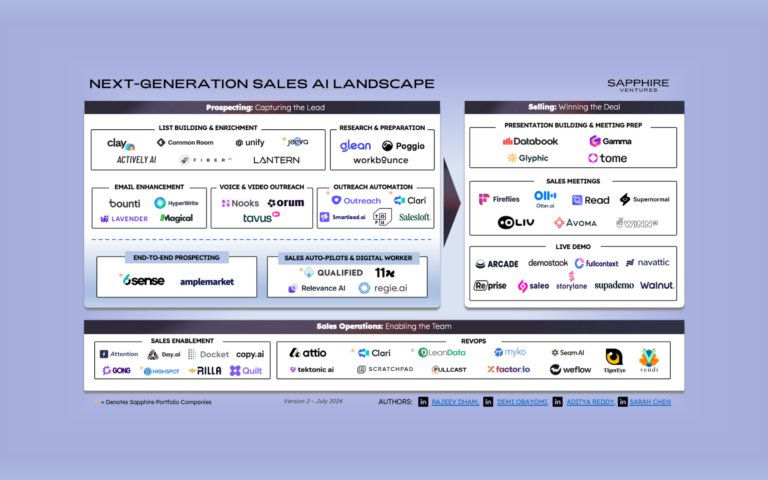In this year’s iteration of Sapphire’s annual CIO Innovation Index survey, enterprise leaders again reported that industry analysts were the second-most used source of information to identify emerging technologies and startups they should evaluable (the first source being introductions from the venture community). That means a majority of G2000 CIOs surveyed see the likes of Gartner, Forrester, and IDC as an important source of insights into the innovation landscape.
Despite the potential value these analysts have for enterprise software companies, the industry analyst landscape is tricky to navigate, especially for small startups. As we’ve been advising portfolio companies on their analyst relations (AR) strategy, we’ve curated five key insights that startup CMOs (and CEOs!) should know about analyst relations:
1. It’s never too early for AR
There’s no downside to beginning to engage analysts via free vendor briefings. Even early-stage companies can benefit from these conversations that help refine your message and get your solution on the radar of these influencers. Plus, you could end up on “new vendor” lists such as Gartner’s Cool Vendors or Forrester’s New Wave.
Your initial investment in AR can be nothing more than the time spent:
- researching relevant analysts and their published research in your space
- booking briefings, and
- crafting a tight message in the form of an initial briefing deck
There is, however, a significant step up in both time and resources from running an occasional vendor briefing to running a formal AR function.
2. Analysts provide value beyond published research
While placement in a research report or coveted Magic Quadrant is a successful outcome, analysts firms deliver value for startups in a variety of other ways, including:
- Providing you with feedback on messaging, product roadmap, pricing and market fit,
- Mentioning your solution to enterprise buyers in advisory conversations, and
- Creating marketing opportunities in the form of analyst-hosted events, or mentioning your company during press interviews
Analysts typically specialize in a specific technology area, and as such they see a broad swath of any given market. This gives them a great vantage point for delivering objective feedback on everything from how to frame your product to enterprise buyers, to prioritizing your product roadmap, and how competitors are positioning themselves. You don’t have to take all of their advice, but a two-way dialogue with a few plugged-in analysts is a valuable source of aggregated feedback on the market.
In addition, most analysts at the major firms spend approximately a third of their time on client-facing engagements: talking to enterprise buyers about their space, their business issues, and possible solutions. Ideally, you’d be top-of-mind for the analysts and they’ll mention your solution in these conversations. Some people may tell you that that mindshare is contingent on how much you spend with that analyst firm, but it’s more likely based on the quality of your interactions with the analyst and — most importantly — the strength of your messaging. Having feedback conversations with analysts early on can help you hone your messaging so that it sticks in the minds of analysts and potential customers alike.
3. Finding the right individual analyst for your company is crucial
There is no exact definition of what an industry “analyst” does — no qualifications they need, no set of activities they have to provide. As a result, not all analysts (or analyst firms) undertake the same sort of activities or have equal value to a startup. Each analyst and firm comes with different skills, expertise, influence, brand and offerings you need to match to your own objectives when engaging them.
To create a valuable AR program, you will need to think about the firm — and the individuals — you choose to work with and the role you want them to play in your go-to-market efforts. For many startups, it will make sense to start with one or two of the “Big Three” analyst firms: Gartner, Forrester, and IDC, because of their breadth of research coverage and ways to engage. In other instances, such as a nascent market, it can make more strategic sense to work with a smaller boutique firm that is willing to dedicate the time to understand a technology before its mainstream.
4. Don’t count out the smaller players
Though the “Big Three” capture a sizable chunk of the industry analyst market, this doesn’t mean smaller, boutique firms have no value to your AR strategy. Analysts at smaller firms can be more inclined to make provocative determinations in their research that can serve as great marketing materials. They’re also likely to give you more opinionated feedback on market fit and messaging. Plus, there are many smaller industry analyst firms that target very specific technology areas and have considerable mindshare in those areas (think: digital twins, 5G, real estate tech, etc.).
5. Peer review sites are gaining traction
Previously, we’ve advised startups to monitor their ratings on the peer review sites (G2, Capterra, Peer Insights, etc.), but to not feel obligated to pay to promote their products on these services unless they had more of a consumer or developer-led sales motion. Recently, however, we’ve seen these peer review sites gain importance as a research source for analysts. In recent cycles, Gartner’s Magic Quadrant reportedly drew from Peer Insights reviews rather than direct customer references. While many enterprise buyers still don’t consider peer reviews an authoritative source, placement in site rankings (and ranking trends over time) does carry some weight and should be monitored.
In addition to their potential long-term value, many startup CMOs mentioned finding it worthwhile to run a few promotional campaigns to ask happy customers for reviews – and then leveraging those positive reviews as content for customer marketing efforts, social campaigns, and other demand gen activities.
The first step is often the hardest
Despite being repeatedly identified as an important decision-making channel for enterprise buyers, many earlier-stage startups we support find it difficult to take that first step to engaging the analyst community. The difficulty comes from not knowing exactly how much value analysts really play in a particular market, and the opportunity cost of investing time on analysts relative to other marketing priorities. In our next article in this series, we’ll highlight how some of Sapphire’s high-growth startups got over the first step of justifying their AR efforts, and how they continue to leverage this channel in their go-to-market mix.
Have thoughts or suggestions on how startups should engage analysts? Let us know at [email protected] and [email protected].



